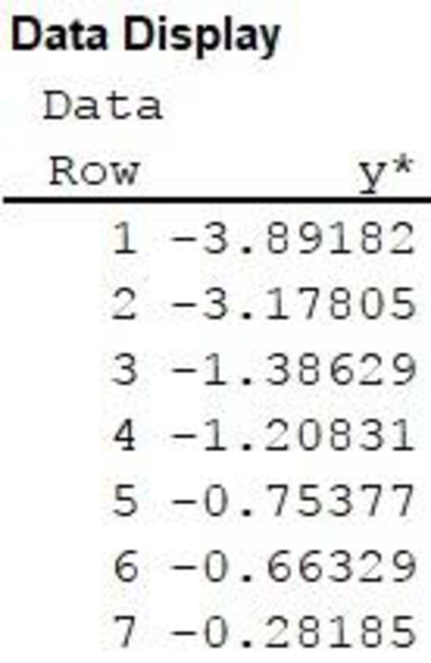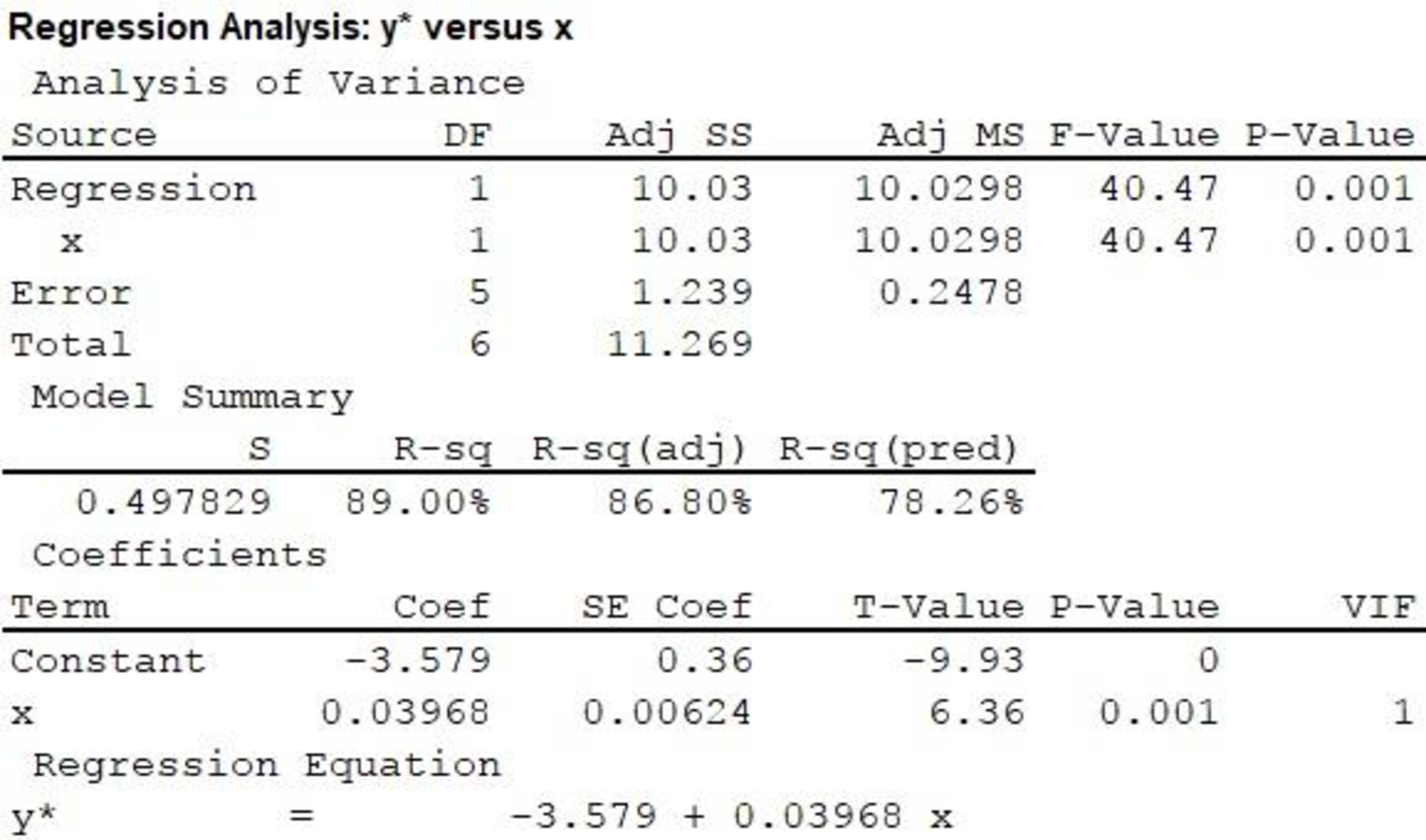
a.
Draw the
a.
Answer to Problem 86E
The scatterplot of the proportion of failing versus the load on the fabric is as follows:

Explanation of Solution
Calculation:
The given data relates the proportion of times a fabric fails, or causes a “wardrobe malfunction” with the load or force applied on it (lb/sq in.).
Denote the proportion of times a fabric fails as p and the load as x.
Scatterplot:
Software procedure:
Step-by-step procedure to draw the scatterplot using MINITAB software is given below:
- Choose Graph > Scatterplot.
- Choose Simple, and then click OK.
- Enter the column of p under Y variables.
- Enter the column of x under X variables.
- Click OK in all dialogue boxes.
Thus, the scatterplot for the data is obtained.
b.
Find the value of
Fit a regression line of the form
Describe the significance of the positive slope.
b.
Answer to Problem 86E
The regression line fitted to the given data is
Explanation of Solution
Calculation:
Logistic regression:
The logistic regression equation for the prediction of a probability for the given value of the explanatory variable, x, is
The values of
Data transformation
Software procedure:
Step-by-step procedure to transform the data using MINITAB software is given below:
- Choose Calc > Calculator.
- Enter the column of y* under Store result in variable.
- Enter the formula LN(‘p’/(1–‘p’)) under Expression.
- Click OK.
The transformed variable is stored in the column y*.
Data display:
Software procedure:
Step by step procedure to display the data using MINITAB software is given as,
- Choose Data > Display Data.
- Under Column, constants, and matrices to display, enter the column of y*.
- Click OK on all dialogue boxes.
The output using MINITAB software is given as follows:

Regression equation:
Software procedure:
Step by step procedure to obtain the regression equation using the MINITAB software:
- Choose Stat > Regression > Regression > Fit Regression Model.
- Enter the column of y* under Responses.
- Enter the columns of x under Continuous predictors.
- Choose Results and select Analysis of Variance, Model Summary, Coefficients, Regression Equation.
- Click OK in all dialogue boxes.
Output obtained using MINITAB is given below:

In the output, substituting
It is observed that the slope of x is 0.03968, which is positive. A positive slope implies that an increase in x causes an increase in yꞌ.
Now, it is known that the quantity
In this case, an increase in load increases the natural logarithm of odds of failure, which, in turn, implies an increase in the odds of failure.
Thus, the positive slope implies that an increase in load causes an increase in the odds of failure of a fabric.
c.
Predict the proportion of failure of a fabric, for a load of 60 lb/sq in.
c.
Answer to Problem 86E
The proportion of failure of a fabric, for a load of 60 lb/sq in. is 0.2318.
Explanation of Solution
Calculation:
For a load of 60 lb/sq in., substitute
Thus,
Thus, the proportion of failure of a fabric, for a load of 60 lb/sq in. is 0.2318.
d.
Estimate the maximum safe load to have a less than 5% chance of failing or wardrobe malfunction.
d.
Answer to Problem 86E
The maximum safe load to have a less than 5% chance of failing or wardrobe malfunction is 16 lb/sq in.
Explanation of Solution
Calculation:
For a 5% chance of failing,
Thus,
As a result, the load for a proportion of failure of 0.05 is 16 lb/sq in.
Now, from the explanation in Part b, an increase in the load causes an increase in the odds of failure. Thus, an increase in load from 16 lb/sq in. would cause an increase in the proportion of failure, whereas a decrease in load from 16 lb/sq in. would cause a decrease in the proportion of failure.
Thus, the maximum safe load to have a less than 5% chance of failing or wardrobe malfunction is 16 lb/sq in.
Want to see more full solutions like this?
Chapter 5 Solutions
INTRODUCTION TO STATISTICS & DATA ANALYS
 College AlgebraAlgebraISBN:9781305115545Author:James Stewart, Lothar Redlin, Saleem WatsonPublisher:Cengage Learning
College AlgebraAlgebraISBN:9781305115545Author:James Stewart, Lothar Redlin, Saleem WatsonPublisher:Cengage Learning
 Mathematics For Machine TechnologyAdvanced MathISBN:9781337798310Author:Peterson, John.Publisher:Cengage Learning,
Mathematics For Machine TechnologyAdvanced MathISBN:9781337798310Author:Peterson, John.Publisher:Cengage Learning,- Algebra & Trigonometry with Analytic GeometryAlgebraISBN:9781133382119Author:SwokowskiPublisher:Cengage
 College Algebra (MindTap Course List)AlgebraISBN:9781305652231Author:R. David Gustafson, Jeff HughesPublisher:Cengage Learning
College Algebra (MindTap Course List)AlgebraISBN:9781305652231Author:R. David Gustafson, Jeff HughesPublisher:Cengage Learning




